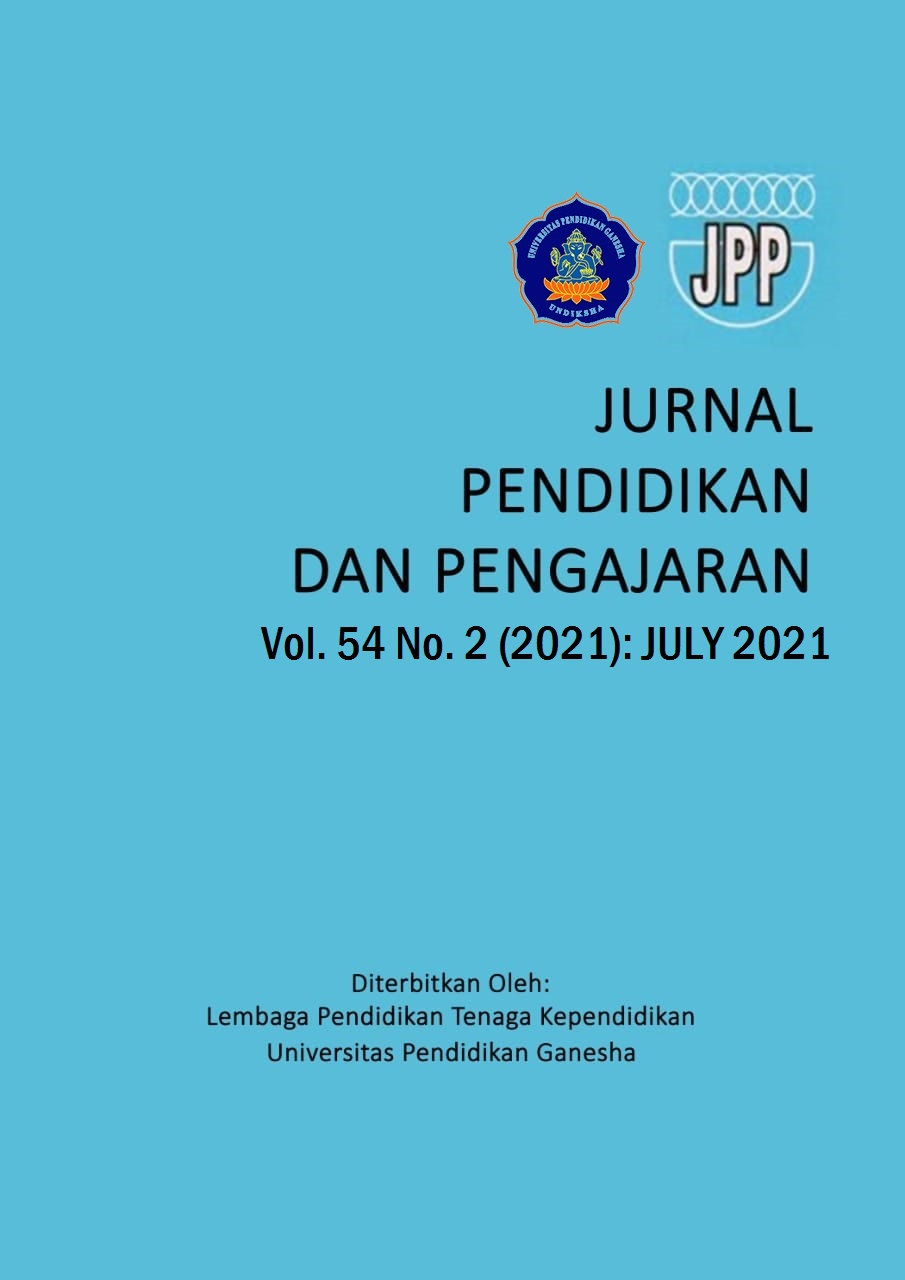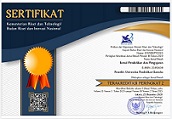The Influence of E-Learning towards Students’ Heutagogy Skills in Higher Education
DOI:
https://doi.org/10.23887/jpp.v54i2.33128Keywords:
e-learning, Self-Directed, Self-RegulatedAbstract
Heutagogy skills are needed by students to take part in the e-learning process during the Covid-19 pandemic. This study examines the measurement model and proved the influence of e-learning towards self-directed, self-regulated, and self-determined learning skills. This research uses a survey method, the data is collected through an online questionnaire which shared with 232 respondents. The research instrument validity was tested by Confirmatory Factor Analysis (CFA) and reliability test by calculating Cronc’bach value. Path Analysis with AMOS 21.0 was used to analyze the relationship between variables. The result confirms that e-learning significantly affected self-regulated learning. Meanwhile, self-regulated learning has a significant effect on self-determined. Path analysis result indicated that e-learning significantly affected self-determined learning if self-directed and self-regulated learning is first developed. The results of this study also provided an empirical basis for other researchers who want to develop independent learning in students through e-learning. Indicators in self-directed learning can be developed in an online learning process, hence, it can be observed directly on student learning outcomes.
References
Aparicio, M., & Bacao, F. (2013). E-learning concept trends. ACM International Conference Proceeding Series, 81–86. https://doi.org/10.1145/2503859.2503872.
Arbor, A., & Greet, D. (2000). Handbook of Self-Regulation. Handbook of Self-Regulation, 451–502. https://doi.org/10.1016/B978-012109890-2/50043-3.
Baird, A. M. (2020). The Self-Determined Student : Teaching Students With Exceptional Needs Self-Determination Through Class-Wide Self-Monitoring through Class-Wide Self-Monitoring [California State University]. https://digitalcommons.csumb.edu/caps_thes_all%0AThis.
Barnard, L., Lan, W. Y., To, Y. M., Paton, V. O., & Lai, S. L. (2009). Measuring self-regulation in online and blended learning environments. Internet and Higher Education, 12(1), 1–6. https://doi.org/10.1016/j.iheduc.2008.10.005.
Beach, P. (2017). Self-directed online learning : A theoretical model for understanding elementary teachers ’ online learning experiences. Teaching and Teacher Education, 61, 60–72. https://doi.org/10.1016/j.tate.2016.10.007.
Blaschke, L. M. (2013). E-Learning and Self-Determined Learning Skills. In Self-Determined Learning Heutagogy in Action (pp. 55–68). Bloomsbury Academic.
Boekaerts, M., & Boekaelrts, M. (2017). Self-regulated Learning: Bridging the Gap between Metacognitive and Metamotivation Theories. Educational Psychologist, 30(4), 195–200. https://doi.org/10.1207/s15326985ep3004.
Bracey, P. (2010). Self-directed learning vs. self-regulated learning: twins or just friends? A comparative review of literature. Proceedings of World Conference on E-Learning in Corporate, Government, Healthcare, and Higher Education 2010, 1, 1600–1607. http://www.editlib.org/p/35780.
Brookfield, S. D. (2009). Self-Directed Learning. In International Handbook of Education for the Changing World of Work (pp. 2615–2627). https://doi.org/10.1007/978-1-4020-5281-1.
Cadorin, L., Bortoluzzi, G., & Palese, A. (2013). Nurse Education Today The Self-Rating Scale of Self-Directed Learning ( SRSSDL ): A factor analysis of the Italian version. YNEDT, 33(12), 1511–1516. https://doi.org/10.1016/j.nedt.2013.04.010.
Can, M. (2012). E-heutagogy for lifelong e-learning. 1, 129–131. https://doi.org/10.1016/j.protcy.2012.02.025.
Cazan, A., & Schiopca, B. (2014). Self-directed learning , personality traits and academic achievement. Procedia - Social and Behavioral Sciences, 127, 640–644. https://doi.org/10.1016/j.sbspro.2014.03.327.
Chemsi, G., Sadiq, M., Radid, M., & Talbi, M. (2020). Study of the self-determined motivation among students in the context of online pedagogical activities. International Journal of Emerging Technologies in Learning, 15(5), 17–29. https://doi.org/10.3991/IJET.V15I05.11392.
Cho, H. J., Levesque-Bristol, C., & Yough, M. (2020). International students’ self-determined motivation, beliefs about classroom assessment, learning strategies, and academic adjustment in higher education. Higher Education. https://doi.org/10.1007/s10734-020-00608-0.
Cole, A. W. (2020). Engagement in metacognition within self-determined learning. CHIIR 2020 - Proceedings of the 2020 Conference on Human Information Interaction and Retrieval, 495–498. https://doi.org/10.1145/3343413.3377943.
Esham, B., & Abdul, F. (2010). Self-directed Learning and Culture : A Study on Malay Adult Learners. Procedia Social and Behavioral Sciences, 7(C), 254–263. https://doi.org/10.1016/j.sbspro.2010.10.036.
Garrison, D. R. (1997). Self-directed learning: Toward a comprehensive model. Adult Education Quarterly, 48(1), 18–33.
Haryono, N., & Octavia, R. (2020). Analisis Pengaruh Citra Merek Dan Mutu Layanan Terhadap Kepuasan Konsumen Serta Dampaknya Terhadap Loyalitas Konsumen. INDEPT, 4(1), 20–27.
Hase, S. (2016). Self-determined Learning (heutagogy): Where Have We Come Since 2000 ? Special Edition of Southern Institute of Technology Journal of Applied Research, 21(May).
Hase, S., & Kenyon, C. (2013). Self-Determined Learning. Bloomsbury Academic.
Kellenberg, F., Schmidt, J., & Werner, C. (2019). The Adult Learner: Self-Determined, Self-Regulated, and Reflective. Journal of Pedagogy and Psychology “Signum Temporis,” 9(1), 23–29. https://doi.org/10.1515/sigtem-2017-0001.
Kolb, D. A. (2015). Experiential Learning: Experience as the Source of Learning and Development. In Pearson Education, Inc. Pearson Education, Inc.
Kulakow, S., & Raufelder, D. (2020). Enjoyment benefits adolescents’ self-determined motivation in student-centered learning. International Journal of Educational Research, 103(June), 101635. https://doi.org/10.1016/j.ijer.2020.101635.
Lasfeto, D. B., & Ulfa, S. (2020). The relationship between self-directed learning and students’ social interaction in the online learning environment. Journal of E-Learning and Knowledge Society, 16(2), 34–41. https://doi.org/10.20368/1971-8829/1135078.
Mamun, M. A. Al, Lawrie, G., & Wright, T. (2020). Instructional design of scaffolded online learning modules for self-directed and inquiry-based learning environments. Computers and Education, 144(December 2018), 103695. https://doi.org/10.1016/j.compedu.2019.103695.
Martin, J. (2004). Self-Regulated Learning, Social Cognitive Theory, and Agency. Educational Psychologist, 39(July 2015), 111–133. https://doi.org/10.1207/s15326985ep3902.
Müller, F. H., & Louw, J. (2004). Learning environment, motivation and interest: Perspectives on self-determination theory. South African Journal of Psychology, 34(2), 169–190. https://doi.org/10.1177/008124630403400201.
Pintrich, P. R. (1995). Understanding self‐regulated learning. New directions for teaching and learning, 1995(63), 3-12. https://onlinelibrary.wiley.com/doi/abs/10.1002/tl.37219956304.
Pintrich, P. R. (2000). The role of goal orientation in self- regulated learning. In Handbook of self-regulation (pp. 451–502). Academic Press.
Reed, T. (2014). Thinking Maps : An Innovative Way To Increase Sixth-Grade Student Achievement In Social Studies (Issue July). Capella University.
Robinson, J. D., & Persky, A. M. (2020). Developing self-directed learners. American Journal of Pharmaceutical Education, 84(3), 292–296. https://doi.org/10.5688/ajpe847512.
Schunk, D. H. (1995). Inherent details of self-regulated learning include student perceptions. Educational Psychologist, 30(4), 213–216. https://doi.org/10.1207/s15326985ep3004.
Schunk, D. H. (2010). Self-Regulated Learning : The Educational Legacy of Paul R . Pintrich. Educational Psychologist, 40(2), 85–94. https://doi.org/10.1207/s15326985ep4002.
Sinatra, G. M. (2014). The Legacy and the Challenges: Paul Pintrich’s Contributiosn to Personal Epistemology Research. Educational Psychologist, 1520(August), 37–41. https://doi.org/10.1207/s15326985ep4002.
Williamson, S. N. (2007). Development of a self-rating scale of self-directed learning. Nurse Researcher, 14(2), 66–83.
Winne, P. H. (2015). Self-Regulated Learning. In International Encyclopedia of Social & Behavioral Sciences (Second Edi, Vol. 21, Issue 2, pp. 535–540). Elsevier. https://doi.org/10.1016/B978-0-08-097086-8.25091-5.
Winne, P. H. (2016). Improving Measurements of Self-Regulated Learning. 1520(December). https://doi.org/10.1080/00461520.2010.517150.
Zhoc, K. C. H., & Chen, G. (2016). Reliability and validity evidence for the Self-Directed Learning Scale (SDLS). Learning and Individual Differences, 49, 245–250. https://doi.org/10.1016/j.lindif.2016.06.013.
Zimmerman, B. J. (1990). Self-Regulated Learning and Academic Achievement : An Overview Self-Regulated Learning and Academic Achievement : An Overview. Educational Psychologist, 25(1), 3–17. https://doi.org/10.1207/s15326985ep2501.
Downloads
Published
How to Cite
Issue
Section
License
Authors who publish with Jurnal Pendidikan dan Pengajaran agree to the following terms:- Authors retain copyright and grant the journal the right of first publication with the work simultaneously licensed under a Creative Commons Attribution License (CC BY-SA 4.0) that allows others to share the work with an acknowledgment of the work's authorship and initial publication in this journal
- Authors are able to enter into separate, additional contractual arrangements for the non-exclusive distribution of the journal's published version of the work (e.g., post it to an institutional repository or publish it in a book), with an acknowledgment of its initial publication in this journal.
- Authors are permitted and encouraged to post their work online (e.g., in institutional repositories or on their website) prior to and during the submission process, as it can lead to productive exchanges, as well as earlier and greater citation of published work. (See The Effect of Open Access)





